Probably you’ve already seen the amazing images of the July 2 solar eclipse taken by DSLWP-B. These have have been shared in Twitter by the Harbin Institute of Technology Amateur Radio club BY2HIT, Tammo Jan Dijkema from the Dwingeloo radiotelescope in the Netherlands, and others.
I have devoted the last few posts to the planning of the imaging times for the eclipse test run and the validation of the test run done on June 30. This post is a detailed account of the results of the eclipse imaging. Between July 3 and 5, five of the six eclipse images taken on July 2 were downloaded, as well as some other images taken later. Here I give a summary of the downloads during these days and compare the images to the predictions I made.
Log of activities between July 3 and 5
The six images taken during the eclipse run had IDs between 0xE1 and 0xE6 (see this post for more information about image IDs). The times at which the images were taken are listed in this post, but keep in mind that these are the times at which the imaging command is sent to the Amateur payload on board DSLWP-B. The payload takes the image approximately 20 seconds after it receives the command.
On July 3, the Amateur payload was activated between 06:00 and 08:00 UTC. The downloading activities were planned and executed very efficiently by Wei Mingchuan BG2BHC, who coordinated the activities, Reinhard Kuehn DK5LA, who operated the uplink station in Germany, and the people operating the Dwingeloo 25m radiotelescope in the Netherlands, which was the main downlink station. Secondary downlink stations at Harbin and Shahe, in China, and Wakayama, in Japan, were used some of the days.
A total of four complete images from the eclipse could be downloaded on July 3. All the DSLWP-B team as well as people following on Twitter were truly impressed with the quality of the images. I was quite relieved when seeing that the Earth was well separated from the Moon in many of the images. My main concern when planning the observations was that an inappropriate imaging time would cause the Earth to be hidden behind the Moon.
The four images downloaded on July 3 are shown below.
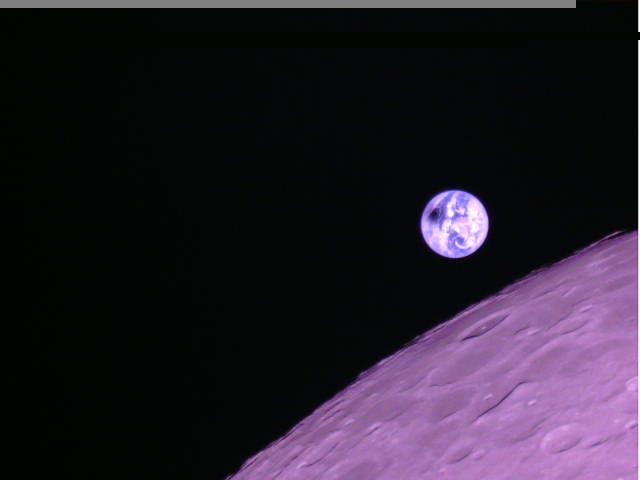
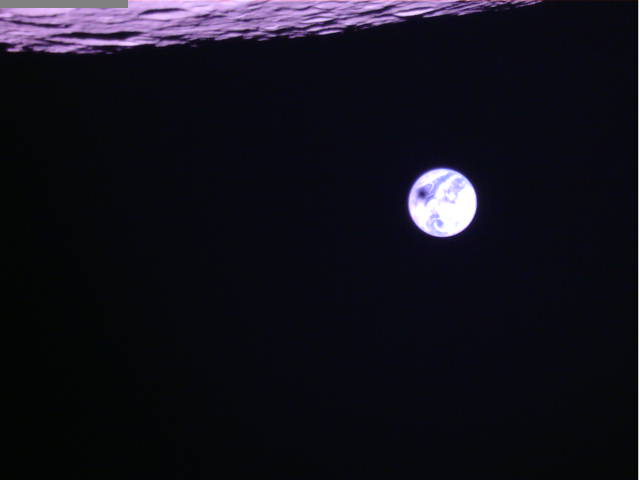


On July 4, the payload was active between 06:30 and 08:30 UTC. First, a few minutes were spent to download the first chunk of image 0xE6, which was missing in the July 3 download.
There is a well known bug with the DSLWP-B SSDV system used to transmit the images that causes the image transmission to start by the second chunk instead of the first one whenever a complete image transmission is requested, so the first chunk is skipped. In many images this first chunk is completely black so its download is not needed, but in others it has to be downloaded manually later on.
The complete image 0xE6 is shown below.
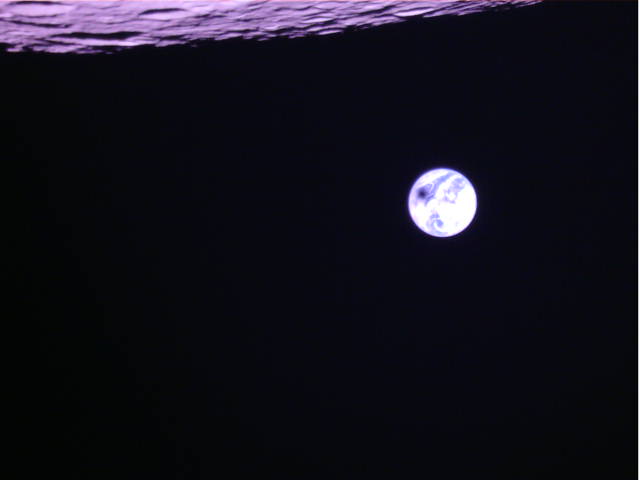
Next, image 0xE4 was downloaded. This was the first of the three images taken as DSLWP-B came out of the occultation. In this image, the Earth is hidden behind the Moon. DSLWP-B is moving towards the lower right corner of the image, so some seconds after this image was taken the Earth would have become visible. Compare with image 0xE5 shown above, which was taken one minute later.
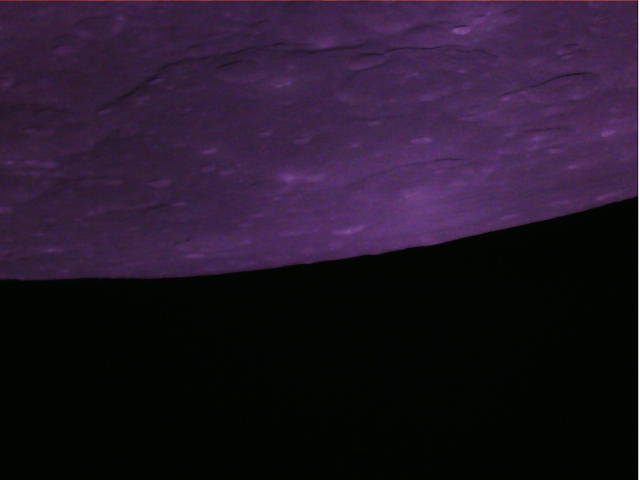
After downloading this image, the settings of the camera were changed to take an image of a field of stars. This involves changing the camera exposure for reduced lighting conditions. The command to take the image was sent by Reinhard around 07:56, so the image was taken approximately at 07:57, since the commands take one minute to be sent.
The download of the image was commanded, but instead of getting an image of stars we got a purple lens flare as we have seen in other occasions. The reason for this is that the Earth was still in the field of view of the camera, overexposing the image. Therefore, the download of the image was commanded to stop, as this kind of image is not very interesting and it is better to devote the time in which the payload is active to other activities.

After stopping the download of image 0xE9, the download of image 0xDC was started. This is one of the images which were taken during the June 30 test run, and which hadn’t been downloaded yet. However, the payload shut off a few minutes after the download started, so only the top part of the image could be downloaded, as shown below.

On July 5, the payload was active between 07:30 and 09:30 UTC. The first task during the activation was to download again image 0xDC. This was completely downloaded, and is shown in the figure below.
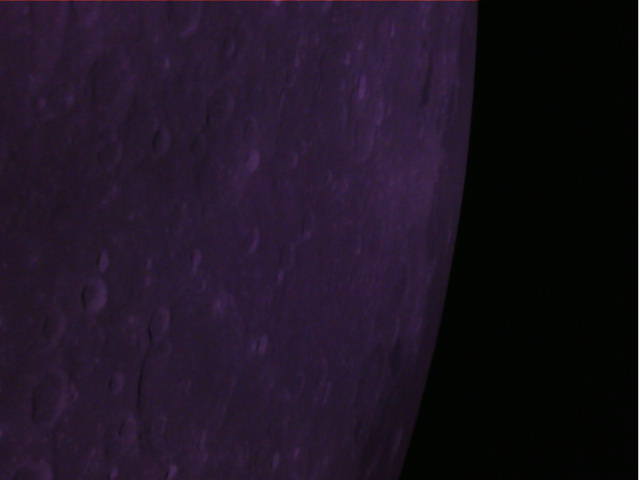
This day, a team of the Chinese NCLE delegation was visiting the Astron premises, where the 25m radiotelescope is housed, so they were taken on a tour of the facilities and given a live demo of the DSLWP-B capabilities at the radiotelescope. The demo consisted in taking and downloading some pictures of the lunar surface.
The plan was to download image 0xE1 after 0xDC. This image was the first of the July 2 eclipse images, and the only one among the six images which hadn’t been downloaded yet. Then, pictures of the Moon surface would be taken manually at 08:25 and 08:29, the satellite would hide behind the Moon between 08:31 and 08:59, and the lunar surface images would be downloaded after the satellite reappeared.
However, image 0xE1 could not be downloaded due to timing constraints, and the command for taking the image at 08:29 wasn’t successful. The command sent at 08:25 did indeed work, and this image could be downloaded almost completely before the payload switched off.

It is quite interesting that this image doesn’t have the peculiar purple hue that is present in almost all the other DSLWP-B images. Indeed, only a few other images taken during the first three months of the mission look yellowish like this one. It was assumed that at some point the yellow channel of the camera sensor might have failed.
However, it seems that the hue has something to do with the exposure settings of the camera. This image was taken with the shortest exposure possible, since the Moon surface would completely fill the image. Most other images don’t use the shortest exposure setting, since the Moon only fills part of the image.
Analysis of the eclipse images
Here I study the July 2 eclipse images obtained by DSLWP-B to compare the positions of the Earth and Moon in the images with the predictions I obtained using GMAT and my camera view Python scripts. The Moon centred ICRF ephemeris given in this post are used here.
In the analysis of the June 30 test run images, I measured the angular distance between the rim of the Moon and the centre of the image. This measurement has the problem that it is sensitive to camera pointing errors. In the eclipse images it is better to measure the separation between the rims of the Earth and the Moon, as this quantity is insensitive to camera pointing errors. For simplicity, only images 0xE2, 0xE5 and 0xE6, in which the Earth is completely visible, are used in the study.
This Jupyter notebook is used to measure the distance between the borders of the Earth and the Moon in pixels. This is then converted to an angular distance in degrees by using the resolution of 107 arcseconds per pixel that I obtained with the astrometry study of the camera (the resolution obtained there was 214 arcseconds per pixel, but here the camera is used with a 2x zoom factor).
The angular distances obtained from the images are then compared to the values obtained from the orbital simulation using the camera view Jupyter notebook. Differences of 0.47, -0.69 and -0.56 degrees are obtained respectively for each of the images.
These differences can be transformed into a temporal difference by dividing by the derivative of the angular distance between the Earth and Moon rims. Doing this, we obtain values of -13.2, -12.9 and -10.8 seconds. Assuming that the ephemeris describe the orbit exactly, this would mean that the images have been taken between 11 and 13 seconds before their nominal times. An alternative explanation is that the images have been taken at their nominal times but DSLWP-B is some 12 seconds earlier in its orbit than what described by the ephemeris.
Since the 20 seconds between the time the command is sent to the payload and the moment that the image is taken is just and approximation, it is not so easy to tell which of these effects is causing the temporal difference of around 12 seconds. Additionally, sometimes the DSLWP-B on board clock is a few seconds off. This would give a third possible explanation.
The only additional data we have to constrain DSLWP-B’s orbit are Scott Tilley VE7TIL’s radio occultation measurements of the S-band beacon done on July 1. After I analyzed the June 30 test run images, Scott was kind enough to observe a radio occultation on short notice.
When DSLWP-B hides behind the Moon, its radio signal disappears. By measuring the exact moments at which the radio signal disappears and the moment at which it reappears back, it is possible to get constraints on the orbital parameters. One of the parameters best constrained by this measurement is the mean anomaly, since an error in mean anomaly will put the satellite somewhat sooner or later in its orbit, shifting both occultation timestamps by the same amount in comparison to the prediction.
Scott measured the start of the occultation to be at 2019-07-01 22:29:02UTC, and the end of the occultation to be at 2019-07-01 23:05:26 UTC. According to my GMAT calculations, which take into account the finite propagation speed of light, the occultation observed by Scott should have started at 22:29:00 and ended at 23:05:15. Therefore, we have an error of -2 seconds in the beginning of the occultation and -11 seconds in the end of the occultation (meaning that the satellite is slightly earlier on its orbit than predicted). This can serve to explain part (or even all) of the temporal difference observed between the images and the prediction.
Another interesting thing to study in the eclipse images is the camera pointing error. This was the main source of confusion when I studied the test run images, since there it was difficult to distinguish a pointing error from an orbit error. In the eclipse images, however, it is very easy to study the pointing error.
Recall that, nominally, the DSLWP-B inory eye camera always points away from the Sun, since it is placed on the opposite side of the solar panel, which is kept pointing towards the Sun. The centre of the eclipse shadow that is seen on the Earth’s surface is located in the line joining the centres of the Moon and the Sun. If the satellite was also placed on this line, then the away-from-Sun vector of the camera would point to the eclipse shadow. Since the satellite is not so far away from the Moon, we can do an approximation and take the eclipse shadow as the away-from-Sun vector. This means that, if the camera pointing was perfect, the eclipse shadow would be centred in the image.
I have measured by hand the location of the eclipse shadow in each of the four eclipse images where it is visible. These locations are shown in the figure below together with one of the eclipse images for reference. I have also included the away-from-Sun vector that I measured in the astrometry image. That image was taken with a 1x zoom factor, while the eclipse images have been taken with a 2x zoom factor, so the position of the away-from-Sun vector, marked as an orange cross, has been corrected for the difference in zoom factor.
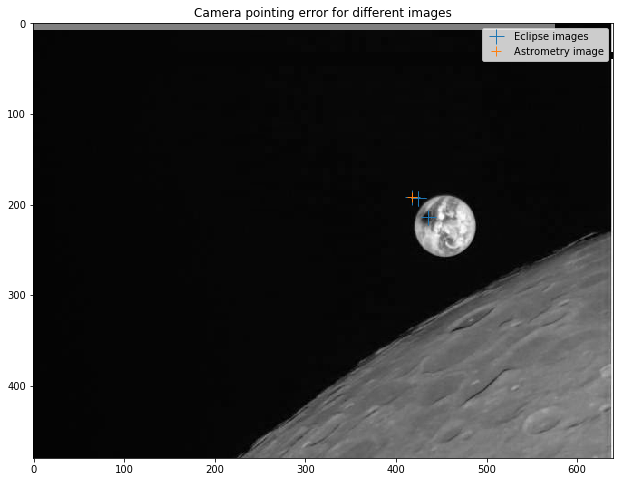
The figure above shows that the pointing error direction and magnitude is very consistent, even between the eclipse images and the astrometry image, which was taken almost a month before the eclipse. The pointing error is approximately 3.3 degrees, roughly towards the lower left corner of the field of view (the crosses should appear in the centre of the image).
This suggests that the most of the pointing error is not caused by an error in the ADCS system DSLWP-B, but rather by the fact that the camera is probably not installed perfectly aligned with the satellite body axes.
3 comments